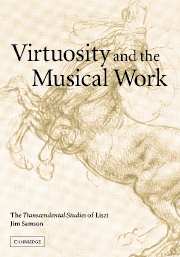7 - Mazeppa times 7
Published online by Cambridge University Press: 22 September 2009
Summary
‘IL TOMBE ENFIN! … ET SE RELÈVE ROI!’
The translation of the fourth of the 1826 exercises into the most tempestuous of the Grandes Etudes, the gladiator of the cycle, invites a little speculation about just what was in Liszt's mind. The early piece, whose links to Cramer have been noted (Ex. 2), is among the least consequential of the exercises in the Etude en douze exercices. It is a simple study in hand-crossing, with a texturally contrasted consequent, cast in a straightforward binary form rounded by a short coda. It was suggested in chapter 2 that we might read into its figure some hint of a chasse motive, or rather that we might easily imagine how Liszt allowed that figure to suggest an equestrian topic when he recomposed the piece in 1837. All the same, we may be inclined to ask not just how he came to think of the figure as an accompaniment for that big, broad, intemperate tune, but also why the figure is presented in an ever more compressed form through successive strophes, in what appears to be such a graphic representation of the frenzied ride of our Cossack hero. In other words, did Liszt conceive this piece as a bravura etude to which he later appended a peculiarly fitting programmatic title, as he surely did with the other etudes? Or was Victor Hugo's poem already lurking in his thoughts when he recomposed the piece in 1837?
- Type
- Chapter
- Information
- Virtuosity and the Musical WorkThe Transcendental Studies of Liszt, pp. 198 - 226Publisher: Cambridge University PressPrint publication year: 2003



